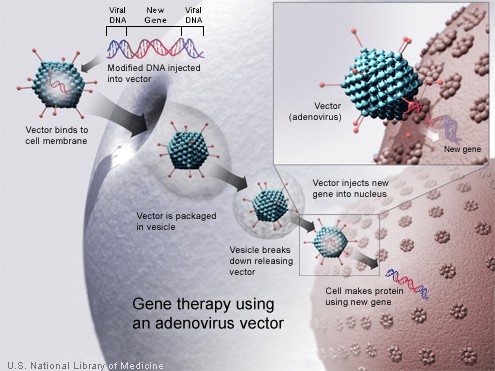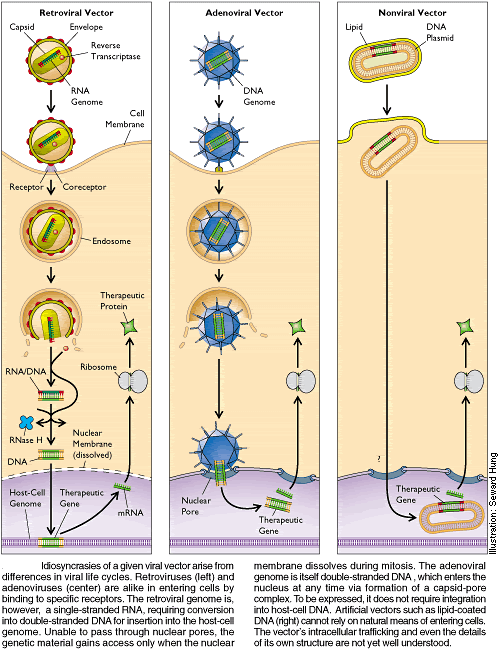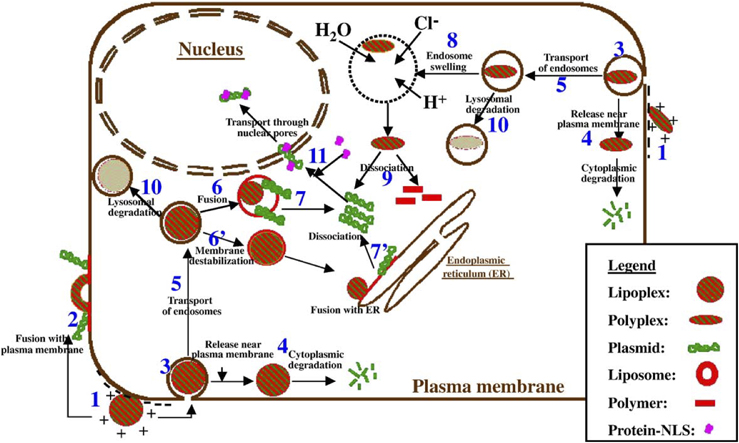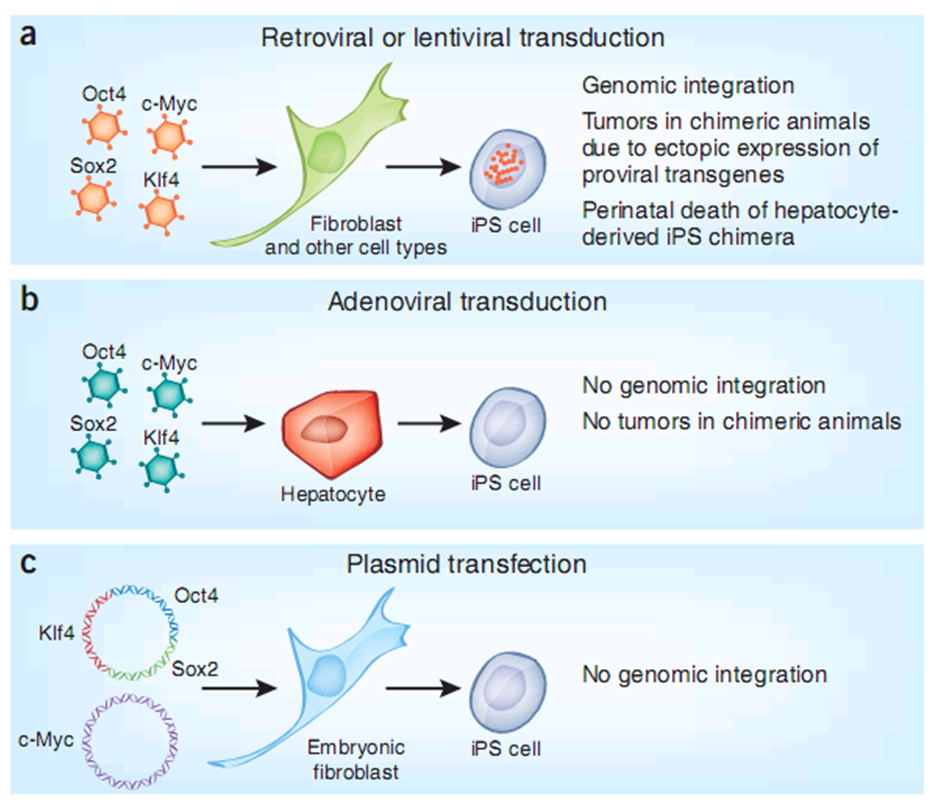Team:Tsinghua/Background
From 2009.igem.org
GuoQiangChen (Talk | contribs) |
(→Gene Therapy) |
||
| (5 intermediate revisions not shown) | |||
| Line 1: | Line 1: | ||
{{Tsinghua/ProjectHeader}} | {{Tsinghua/ProjectHeader}} | ||
| + | |||
= '''Background''' = | = '''Background''' = | ||
| Line 6: | Line 7: | ||
== Gene Therapy == | == Gene Therapy == | ||
Gene therapy is defined as the introduction of genes into tissues or cells via gene transfer, with the purpose of deriving a therapeutic or preventative benefit from the function of these genes. It is the insertion of genes into an individual's cells and tissues to treat a disease, such as a hereditary disease in which a deleterious mutant allele is replaced with a functional one[1]. Although the technology is still in its infancy, it is one of the most promising and active research fields in medicine[1,2]. Antisense therapy is not strictly a form of gene therapy, but is a genetically-mediated therapy and is often considered together with other methods[1]. | Gene therapy is defined as the introduction of genes into tissues or cells via gene transfer, with the purpose of deriving a therapeutic or preventative benefit from the function of these genes. It is the insertion of genes into an individual's cells and tissues to treat a disease, such as a hereditary disease in which a deleterious mutant allele is replaced with a functional one[1]. Although the technology is still in its infancy, it is one of the most promising and active research fields in medicine[1,2]. Antisense therapy is not strictly a form of gene therapy, but is a genetically-mediated therapy and is often considered together with other methods[1]. | ||
| - | [[Image:gene therapy.png|center|caption|500px]] | + | [[Image:gene therapy.png|center|caption|500px|thumb|Gene therapy using an adenovirus vector]] |
Recently scientific breakthroughs in the genomics field made gene therapy one of the most rapidly advancing fields of biotechnology and we can have a better understanding of the role of genes in disease with great promise for treating inherited and acquired diseases. | Recently scientific breakthroughs in the genomics field made gene therapy one of the most rapidly advancing fields of biotechnology and we can have a better understanding of the role of genes in disease with great promise for treating inherited and acquired diseases. | ||
| Line 12: | Line 13: | ||
With the steps moving from the laboratory into the clinic, several issues have been brought in a central role of the development of this technology: gene identification, gene expression and gene delivery. More and more disease-related genes are found one by one, which is still growing on a rapid speed. Broader clinical application of related genes are also being utilized to develop immune activating agents with an acurate targeting site[20]. | With the steps moving from the laboratory into the clinic, several issues have been brought in a central role of the development of this technology: gene identification, gene expression and gene delivery. More and more disease-related genes are found one by one, which is still growing on a rapid speed. Broader clinical application of related genes are also being utilized to develop immune activating agents with an acurate targeting site[20]. | ||
| - | [[Image:gene therapy2.png|center|caption|500px]] | + | [[Image:gene therapy2.png|center|caption|500px|thumb|Differents types of vectors used in gene therapy]] |
== Vectors in Gene Therapy == | == Vectors in Gene Therapy == | ||
| Line 54: | Line 55: | ||
| - | [[Image:Lipoplexes and polyplexes.png|center|caption|600px]] | + | [[Image:Lipoplexes and polyplexes.png|center|caption|600px|thumb|non-viral method]] |
== Types of Gene Therapy == | == Types of Gene Therapy == | ||
| Line 74: | Line 75: | ||
=== Induced Pluripotent Stem Cell (iPS) and Gene Delivery System=== | === Induced Pluripotent Stem Cell (iPS) and Gene Delivery System=== | ||
| - | [[Image:iPS.png|center|caption|500px]] | + | [[Image:iPS.png|center|caption|500px|thumb|gene delivery system]] |
In 2006, Shinya Yamanaka et al showed that mouse embryonic and adult fbroblasts acquire properties similar to those of embryonic stem (ES) cells after retrovirally introducing genes encoding four transcription factors, namely Oct3/4, Sox2, Klf4, and c-Myc (known as iPS). In 2007, mouse and human iPS cells were generated[4]. | In 2006, Shinya Yamanaka et al showed that mouse embryonic and adult fbroblasts acquire properties similar to those of embryonic stem (ES) cells after retrovirally introducing genes encoding four transcription factors, namely Oct3/4, Sox2, Klf4, and c-Myc (known as iPS). In 2007, mouse and human iPS cells were generated[4]. | ||
| Line 137: | Line 138: | ||
[21] http://www.nature.com/reviews/focus/microrna/editors/nrg2202.pdf Nature Reviews | [21] http://www.nature.com/reviews/focus/microrna/editors/nrg2202.pdf Nature Reviews | ||
| - | [22]http:// | + | [22]http://cmbi.bjmu.edu.cn/cmbidata/therapy/index/index.htm |
| - | [23]http:// | + | [23]http://images.google.cn/imglanding?imgurl= |
| - | [24] | + | [24] http://www.nature.com/mt/journal/v11/n3/images/mt200545f1.jpg&imgrefurl=http://www.nature.com/mt/journal/v11/n3/fig_tab/mt200545f1.html&usg=__16PMODxAS0ot0uFh5qHjoNgcvmE%3D&h=443&w=739&sz=215&hl=zh-CN&um=1&tbnid=b9vKbApcf9TRPM:&tbnh=85&tbnw=141&prev=/images%3Fq%3DLipoplexes%26hl%3Dzh-CN%26um%3D1%26newwindow%3D1&q=Lipoplexes&um=1&newwindow=1&start=0#start=0 |
[25]william e Lowry & Kathrin Plath. The many ways to make an iPS cell. Nature, 26:1246-1248. | [25]william e Lowry & Kathrin Plath. The many ways to make an iPS cell. Nature, 26:1246-1248. | ||
Latest revision as of 16:46, 21 October 2009
| Home | Background | Brainstorming | Design | Experiment | Results | Conclusion | Protocol |
|---|
Contents |
Background
On September 14, 1990 at the U.S. National Institutes of Health, W. French Anderson M.D. and his colleagues R. Michael Blaese, M.D., C. Bouzaid, M.D., and Kenneth Culver, M.D., performed the first approved gene therapy procedure on four-year old Ashanthi DeSilva. Born with a rare genetic disease called severe combined immunodeficiency (SCID), she lacked a healthy immune system, and was vulnerable to every passing germ or infection. In Ashanthi's gene therapy procedure, doctors removed white blood cells from the child's body, let the cells grow in the laboratory, inserted the missing gene into the cells, and then infused the genetically modified blood cells back into the patient's bloodstream. Then, with such controversy, the gene therapy initiate.
Gene Therapy
Gene therapy is defined as the introduction of genes into tissues or cells via gene transfer, with the purpose of deriving a therapeutic or preventative benefit from the function of these genes. It is the insertion of genes into an individual's cells and tissues to treat a disease, such as a hereditary disease in which a deleterious mutant allele is replaced with a functional one[1]. Although the technology is still in its infancy, it is one of the most promising and active research fields in medicine[1,2]. Antisense therapy is not strictly a form of gene therapy, but is a genetically-mediated therapy and is often considered together with other methods[1].
Recently scientific breakthroughs in the genomics field made gene therapy one of the most rapidly advancing fields of biotechnology and we can have a better understanding of the role of genes in disease with great promise for treating inherited and acquired diseases. the absence or inappropriate presence of a protein results in many human diseases. The protein could then be administered to patients in order to compensate for its absence. Nowadays gene therapy is the ultimate method of protein delivery. With the steps moving from the laboratory into the clinic, several issues have been brought in a central role of the development of this technology: gene identification, gene expression and gene delivery. More and more disease-related genes are found one by one, which is still growing on a rapid speed. Broader clinical application of related genes are also being utilized to develop immune activating agents with an acurate targeting site[20].
Vectors in Gene Therapy
Despite substantial progress, a number of key technical issues need to be resolved before gene therapy can be safely and effectively applied in the clinic, and an ideal gene delivery vector is one of the bottlenecks in gene therapy application[3]. Generally, vectors applied in gene therapy can be classified into viral or non-viral.
Viral Methods
All viruses bind to their hosts and introduce their genetic material into the host cell as part of their replication cycle. This genetic material contains basic 'instructions' of how to produce more copies of these viruses, hijacking the body's normal production machinery to serve the needs of the virus[1].
- Adenovirus.
Adenoviruses are kinds of viruses, which carry their genetic material in the form of double-stranded DNA. Respiratory, intestinal, and eye infections are caused when these viruses infection occur. And then they introduce their DNA molecule into the host. The information contained in the adenoviruses is not transient into the host cell's genetic material, while the DNA molecule is left free in the nucleus of the host cell, leading to the final transcription of the target gene just like others.
- Adeno-associated virus.
Adeno-associated viruses is one of the parvovirus families, which are small viruses with a single stranded DNA. The wild type AAV can insert into chromosome 19 at a specific site with near 100% certainty. But the recombinant AAV, with no viral genes contained, failed to integrate into the genome. What's more, instead the recombinant viral genome fuses at its ends via the ITR (inverted terminal repeats) recombination to form circular, episomal forms which are predicted to be the primary cause of the long term gene expression.
- Retroviruses.
The genetic information in retroviruses is saved in the form of RNA molecules, while the genetic material of their hosts is in the form of DNA. When the infection happened a host cell, the introduction of its RNA together with some enzymes such as reverse transcriptase and integrase, were made full use of. This RNA molecule from the retrovirus must produce a DNA copy from its RNA molecule before it can be integrated into the genetic material of the host cell.
- Envelope protein pseudotyping of viral vectors
Different from the viral vectors described above, which have natural host cell populations that they infect most efficiently, attachment to and entry into a susceptible cell is mediated by the protein envelope on the surface of a virus. On the contrary, retroviruses have limited natural host cell ranges, and although adenovirus and adeno-associated virus are able to infect a relatively broader range of cells efficiently, some cell types are refractory to infection by these viruses as well[1].
Non-Viral Methods
Non-viral methods present certain advantages over viral methods, with simple large scale production and low host immunogenicity being just two. Previously, low levels of transfection and expression of the gene held non-viral methods at a disadvantage; however, recent advances in vector technology have yielded molecules and techniques with transfection efficiencies similar to those of viruses[1].
Naked DNA Naked DNA is the simplest method of non-viral transfection. However, it is a fact that the low expression is a shortage in comparison to other methods of transfection, which became a main limit of this method. In addition to trials with plasmids, there have been trials with naked PCR product, which have had similar or greater success. And the success leads to more research into more efficient methods for delivery of the naked DNA namely electroporation, sonoporation, and the use of a "gene gun", shooting DNA into the cell using high pressure gas.
Oligonucleotides. As we all know, synthetic oligonucleotides is mainly used in gene therapy by inactivating the genes involved in the disease process. And several methods can achieve this aim. One strategy uses antisense specific to the target gene to disrupt the transcription of the faulty gene. Another uses small molecules of RNA called siRNA to signal the cell to cleave specific unique sequences in the mRNA transcript of the faulty gene, disrupting translation of the faulty mRNA, then eventually the expression of the gene.
Lipoplexes and polyplexes. Aiming at improving the delivery of the new DNA into the cell, the DNA must be protected from damage and its entry into the cell must be facilitated. For this reason, lipoplexes and polyplexes have been created to protect the DNA from undesirable degradation during the transfection process.
Hybrid methods Due to every method of gene transfer having shortcomings, there have been some hybrid methods developed that combine two or more techniques. Virosomes are one example, which combine liposomes with an inactivated HIV or influenza virus. This has been shown to have more efficient gene transfer in respiratory epithelial cells than either viral or liposomal methods alone. Other methods involve mixing other viral vectors with cationic lipids or hybridising viruses.
Dendrimers Dendrimer, highly branched macromolecule, have a spherical shape. The surface of the particle may varies in a large range and many of the properties of the resulting construct are determined by its surface. Particularly it is possible to construct a cationic dendrimer.On reaching its destination the dendrimer-nucleic acid complex is then taken into the cell via endocytosis.
Types of Gene Therapy
Germ line gene therapy
In the case of germ line gene therapy, germ cells, i.e., sperm or eggs, are modified by the introduction of functional genes, which are ordinarily integrated into their genomes. Therefore, the change due to therapy would be heritable and would be passed on to later generations. This new approach, theoretically, should be highly effective in counteracting genetic disorders. However, many jurisdictions prohibit this for application in human beings, at least for the present, for a variety of technical and ethical reasons.
Somatic gene therapy
In the case of somatic gene therapy, therapeutic genes are transferred into the somatic cells of a patient. Any modifications and effects will be restricted to the individual patient only, and will not be inherited by the patient's offspring.
Difficulty of Current Gene Therapy Approach
In the laboratory, gene transfer is a powerful tool that can be readily adapted to meet the needs of an individual investigator. In the clinical arena, however, gene therapy is more complex and requires consideration of the interplay between the disease and the patient, along with any other conventional treatments being administered.
One of the difficulties in advancing gene therapy technology from the laboratory to the clinic is that the perfect vector system has yet to be created. In clinical gene therapy, the ideal vector would be administered through a noninvasive route, transducing only the desired cells within the target tissue. This vector would then allow for expression of therapeutic amounts of the transgene product with desired regulation for a defined length of time. By definition, gene therapy should be able to replace, augment, or block gene expression toward a specific therapeutic goal. Another major restriction in treating cancer with gene therapy is the limitations in specifically targeting tumor cells, especially cells sthat have metastasized into the systemic circulation.
Frontiers in Gene Therapy
Induced Pluripotent Stem Cell (iPS) and Gene Delivery System
In 2006, Shinya Yamanaka et al showed that mouse embryonic and adult fbroblasts acquire properties similar to those of embryonic stem (ES) cells after retrovirally introducing genes encoding four transcription factors, namely Oct3/4, Sox2, Klf4, and c-Myc (known as iPS). In 2007, mouse and human iPS cells were generated[4].
In 2008, Qiao Zhou et al identify a specific combination of three transcription factors (Ngn3, Pdx1 and Mafa) that reprograms differentiated pancreatic exocrine cells in adult mice into cells that closely resemble beta-cells. These reprogrammed cells express genes essential for b-cell function and can ameliorate hyperglycaemia by remodelling local vasculature and secreting insulin. This approach implies a promising application of reprogramming on diabetes therapy[5].
The booming research on iPS and the subsequent in vivo reprogramming implicate an enormous future. In addition to the obstacles of transformation risks and low efficiency, specifically delivering certain transcription factors into the targeted cells is another problem before the medical and pharmaceutical applications of reprogramming.
Therapeutic microRNA Delivery
Frequently referred to as ‘micromanagers of gene expression’, miRNAs were first identified as regulators of developmental timing in Caenorhabditis elegans. Since then, molecular biologists have been hard at work dissecting the pathways that govern the biogenesis of these small RNA molecules.Another important focus for molecular biologists has been the exact mechanism by which miRNAs bring about translational silencing of their targets. Recent publications indicate that this much-disputed topic might in fact be close to its resolution[21]. Therapeutic strategies based on modulation of microRNA (miRNA) activity hold great promise due to the ability of these small RNAs to potently influence cellular behavior[6].
Cancer Gene Therapy
As a primary threat of human health, cancer causes about 13% of all human deaths[7]. According to the American Cancer Society, 7.6 million people died from cancer in the world during 2007[8]. Current treatments often have far-reaching negative side effects[9]. The systemic toxicity of chemotherapy regimens still often result in acute and delayed nausea, mouth ulcerations and mild cognitive impairments[10]. Squamous cell carcinoma of the head and neck afflicts approximately 500,000 patients per year. The first-line treatment, chemotherapy, induces a response in only 30–40% of patients, and tumors frequently recur. Alternative cancer therapy approaches have been based on oncolytic viruses, which selectively attack tumor, but not normal, cells. One of these, ONYX-015, was initially tested in a Phase I clinical trial in April 1996. In this issue, Khuri et al. report that ONYX-015, when combined with chemotherapy, promotes tumor regression in patients with recurrent squamous cell cancer of the head and neck[11].
References
[1] http://en.wikipedia.org/wiki/Gene_therapy
[2] SM Selkirk. Gene therapy in clinical medicine. Postgraduate Medical Journal.2004;80:560-570; doi:10.1136/pgmj.2003.017764
[3] RC Mulligan. The basic science of gene therapy. Science, 1993, Vol 260, Issue 5110, 926-932.
[4] Shinya Yamanaka. A Fresh Look at iPS Cells. Cell (2009), 137:13-17.
[5]Qiao Zhou, Juliana Brown, Andrew Kanarek, Jayaraj Rajagopa and Douglas A. Melton. In vivo reprogramming of adult pancreatic exocrine cells to beta-cells. Nature (2008), 455:627-633.
[6] Janaiah Kota, Raghu R. Chivukula, Kathryn A. O’Donnell, Erik A. Wentzel, Chrystal L. Montgomery, Hun-Way Hwang, Tsung-Cheng Chang, Perumal Vivekanandan, Michael Torbenson, K. Reed Clark, Jerry R. Mendell,and Joshua T. Mendell. Therapeutic microRNA Delivery Suppresses Tumorigenesis in a Murine Liver Cancer Model. Cell. 2009, 137. 1005–1017.
[7] WHO (February 2006). "Cancer". World Health Organization. http://www.who.int/mediacentre/factsheets/fs297/en/. Retrieved on 2007-06-25.
[8] American Cancer Society (December 2007). "Report sees 7.6 million global 2007 cancer deaths". Reuters. http://www.reuters.com/article/healthNews/idUSN1633064920071217. Retrieved on 2008-08-07.
[9] Peter Sinnaeve, Olivier Varenne, Désiré Collen, and Stefan Janssens. Gene therapy in the cardiovascular system: an update. Cardiovasc Res, Dec 1999; 44: 498 - 506.
[10] Chemotherapy and you: A guide to self-help during cancer treatment. National Institutes of Health Web site. Available at: http://www.cancer.gov/PDF/b21d0a74-b477-41ec-bdc0-a60bbe527786/chemoandyou.pdf. Accessed July 31, 2006.
[11] Gene therapy scores against cancer. NATURE MEDICINE, VOLUME 6, NUMBER 8, AUGUST 2000
[12] Hurdles and Hopes for Cancer Treatment Kelly K. Hunt and Stephan A.Vorburger 2008
[13] Vascular Gene Therapy Brian S. Zuckerbraun, MD; Edith Tzeng, MD
[14] Gene Therapy of Human Severe Combined Immunodeficiency (SCID)-X1 Disease Marina Cavazzana-Calvo and so on
[15] Adenovirus Receptors Yuanming Zhang and Jeffrey M. Bergelson
[16] Role of av Integrins in Adenovirus Cell Entry and Gene Delivery GLEN R. NEMEROW* AND PHOEBE L. STEWART
[17] A programme for the construction of a lambda phage W. J. BRAMMAR AND C. HADFIELD
[18] Genetic Map of Bacteriophage Lambda HARRISON ECHOLS AND HELIOS MURIALDO
[19] A tractable method for simultaneous modifications to the head and tail of bacteriophage lambda and its application to enhancing phage-mediated gene delivery Christine N. Zanghi, Ramil Sapinoro, Birgit Bradel-Tretheway andStephen Dewhurst
[20] http://cmbi.bjmu.edu.cn/cmbidata/therapy/index/index.htm
[21] http://www.nature.com/reviews/focus/microrna/editors/nrg2202.pdf Nature Reviews
[22]http://cmbi.bjmu.edu.cn/cmbidata/therapy/index/index.htm
[23]http://images.google.cn/imglanding?imgurl=
[24] http://www.nature.com/mt/journal/v11/n3/images/mt200545f1.jpg&imgrefurl=http://www.nature.com/mt/journal/v11/n3/fig_tab/mt200545f1.html&usg=__16PMODxAS0ot0uFh5qHjoNgcvmE%3D&h=443&w=739&sz=215&hl=zh-CN&um=1&tbnid=b9vKbApcf9TRPM:&tbnh=85&tbnw=141&prev=/images%3Fq%3DLipoplexes%26hl%3Dzh-CN%26um%3D1%26newwindow%3D1&q=Lipoplexes&um=1&newwindow=1&start=0#start=0
[25]william e Lowry & Kathrin Plath. The many ways to make an iPS cell. Nature, 26:1246-1248.
 "
"



